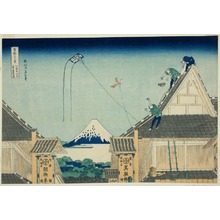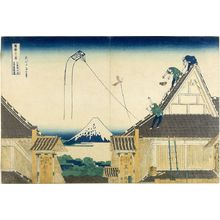Japanischer Druck "View of the Mitsui Stores at Surugachö in Edo" von Katsushika Hokusai
Künstler:Katsushika Hokusai
Titel:View of the Mitsui Stores at Surugachö in Edo
Datum:c. 1830 - 1834
Details:Mehr Informationen...
Quelle:Honolulu Museum of Art
Durchsuchen aller 5.476 Drucke...
Beschreibung:
The Surugachö district of Edo was located just north of Nihonbashi Bridge in the area now called Muromachi 3-chome. Among the larger stores was the Echigoya Mitsui Clothing Store, today known as Mitsukoshi, Japan’s largest modern department store. The store became very successful after adopting a new business practice, payment in cash at time of sale, instead of accruing charges to customers’ accounts. By eliminating the traditional practice of billing customers only once or twice a year, the store was able to sell goods at reduced princes. The Surugachö district was a famous spot for seeing Mount Fuji clearly, especially on a chilly winter day. In this print, the street is flanked with two Mitsui stores, each with a sign stating “Clothing” (right) and “Braided Cords and Threads” (left). Both signs have mottoes stating the store’s policy – “Cash Payment” and “No Padded Prices.” Hokusai extremely exaggerated the perspective, taking a very high position from a foreground point on the roof, which looks down to the horizon. He thus brought the two buildings very close to the viewer, showing only the second floors and roofs, where the roof repairmen work. This extremely steep perspective also drops other buildings from sight, ingeniously creating a clear space for Fuji. Before Hokusai launched the Fuji series, he studied all forms and movement of nature, humans, and animals, and published his drawing books, the Hokusai Manga. These workmen’s postures are recorded in the Manga. The two flying kites indicate the season is winter, on New Year’s Day. The key-block was printed in blue. (The Asian Art Museum of San Francisco, HOKUSAI AND HIROSHIGE – Great Japanese Prints from the James A. Michener Collection, Honolulu Academy of Arts: The Asian Art Museum of San Francisco, 1998 Page 75. Cat. 26) ****************** The Mitsui Clothing Store just north of Nihonbashi (Japan Bridge) was the predecessor of modern Mitsukoshi, the largest department store in Japan. By Hokusai’s time the store had adopted an innovative business practice of expecting cash payment at the time of sale, which allowed them to establish low, fixed prices. Accordingly, the signs to either side read “Cash Payment” and “No Padded Prices.” By abandoning the traditional system of customer accounts paid only a few times each year, the Mitsui Family was able to build one of the most successful financial empires in twentieth century Japan. Surugachö was famous for its fine views of Mount Fuji. In this print, Hokusai has cropped the foreground and used a high viewing angle to eliminate details of the street, thereby establishing Mount Fuji as the main subject. Its form is repeated in the roof of the store, which is being repaired by three workmen. The two kites in the upper center indicate that it is New Year’s Day; Mount Fuji was closely connected with New Year’s festivities, and a dream of the mountain at this time was especially auspicious. “Hokusai’s Summit: Thirty-six Views of Mount Fuji” (09/24/2009-01/06/2010) ******************************
Ähnliche Drucke









![[Kōto suruga-cho mitsu miseryakuzu] Japanischer Druck "[Kōto suruga-cho mitsu miseryakuzu]" von Katsushika Hokusai, 葛飾北斎 (Katsushika Hokusai)](https://data.ukiyo-e.org/loc/thumbs/02461v.jpg)









